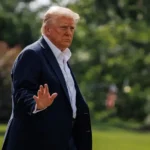
Then, with a near-perfect shot, Bindra won India’s first individual Olympic gold.
It was a historic achievement that many in India hoped would represent a turning point for the giant country after decades of underperforming at the Olympics.
But 16 years, four Summer Olympics and just one gold medal later, those dreams have not come true.
Home to more than 1.4 billion people, India is the world’s most populous country, according to the United Nations. In 2022, India overtook Britain as the world’s fifth-largest economy, and last year it became one of only four countries to successfully land a spacecraft on the moon. And it’s led by an ambitious prime minister who wields broad influence on the global stage.
But when it comes to the Olympics, India doesn’t stand out.
India won just six medals in Paris, falling short of their record seven in Tokyo 2021.
The United States, with less than a quarter of India’s population, topped the table with 126 medals, followed by China with 91.
India ranked 71st in the medals table, below nations with much smaller populations such as Georgia, Kazakhstan and North Korea.
India has won only 41 Olympic medals in total since its debut in 1900, all at the Summer Olympics.
“There is no doubt that India has underperformed in the Olympics and in global sports generally,” said Ronojoy Sen, author of “Nation at Play: A History of Sport in India.”
“If you look at the population to medal ratio, it’s probably the worst.”
Among India’s standout performers in Paris, javelin ace Neeraj Chopra added silver to the gold he won in Tokyo 2020, while shooter Manu Bhaker claimed double bronze to become the first Indian woman to win two medals at the same Games.
Vinesh Phogat, known for her prominent role in protests against sexual harassment, became the first Indian woman to qualify for a wrestling final in the women’s 50kg freestyle – only to be disqualified for failing to make her weight category. On Wednesday, her appeal for a silver medal was rejected by the Court of Arbitration for Sport.
CNN has reached out to the Indian Olympic Association for comment on the team’s performance in Paris.
Big obstacles
India’s history of untapped Olympic potential can be explained by several factors, according to experts, with underinvestment in sports being a major culprit.
New Delhi has never invested resources in a national training program like those of traditional Olympic powers, which have long considered gold medals a symbol of national strength, Sen said.
“For nations like the US, China and the (then) Soviet Union, sport was an important part of their nascent national history, it was a means to global recognition and glory,” he said.
The most successful Olympic nations also identify and develop talent early, he added, pointing to China, where “you see kids being trained from the moment they can walk.”
Indian athletes often face hurdles such as inadequate funding and lack of access to facilities, analysts say.
“When people say 1.4 billion people and only (six) medals, that’s a totally wrong headline because … 1.39 billion people don’t have access to sports facilities,” said Boria Majumdar, a sports analyst and author of “Dreams of a Billion: India and the Olympic Games.”

India sends far fewer athletes and support staff to the Olympics than major teams like the U.S., Majumdar said. For example, 117 Indian competitors went to Paris, compared with nearly 600 Americans.
India also faces broader health challenges that impede development and limit sporting potential from an early age, experts say.
India ranked 111th out of 125 countries in the 2023 Global Hunger Index report. At 18.7%, it has the world’s highest rate of child wasting — the number of children who are too thin for their height — reflecting acute malnutrition. More than a third of children under 5 in India are stunted due to malnutrition, meaning they are too short for their age, according to the report.
“Until we address some of these basic concerns around nutrition, it will be very difficult for us to achieve greater excellence at the highest level of sport, where victories are counted in milliseconds,” Sen said.
Another challenge to Olympic progress is the additional barriers faced by female athletes in India, which remains a deeply patriarchal nation.
“Since childhood, when I started wrestling, people would tease me saying, ‘She’s a girl, what can she do? Why is she getting into a men’s sport?’” said Sakshi Malik, an Indian wrestler who won bronze at the 2016 Rio Olympics.
Malik quit wrestling last year amid controversy over sexual harassment allegations against India’s wrestling chief, which saw Malik, Phogat and other wrestlers sleep on the streets of Delhi for weeks demanding action.
“I gave up my sport that I love above all else for this fight because I carry this responsibility to protect the younger athletes that come after me,” Malik said. “Things have to change.”

Untapped potential
While India’s overall performance in Paris was unimpressive, fans celebrated the achievements of the country’s medallists in social media posts in a show of pride and admiration.
Individual athletes have the power to galvanize a population, Majumdar said.
“To think that the whole country is watching the javelin throw at 2am because of one man is a revolution,” he said, referring to the millions who watched at home as India’s Chopra won silver in Paris.
India’s enormous Olympic potential is perhaps best highlighted by its status in cricket, by far the country’s most popular sport and in which it has become the dominant global force.
Cricket has not been included in the Olympics since 1900 but is set to return in Los Angeles 2028, much to the delight of Indian fans and players who will be gunning for gold.
While cricket’s multi-million dollar Indian Premier League is the most visible sign of sporting investment in the country, other sports have also received a boost in recent years – both from increased corporate sponsorship and government funding.
In 2018, Prime Minister Narendra Modi launched “Khelo India” or “Let’s Play India”, a national programme to “revive sports culture” in the country with the aim of identifying and funding promising young talent, particularly in rural areas.
In the same year, India also revamped its Target Olympic Podium Scheme (TOPS), which supports and funds training, international competitions, equipment and coaching for elite athletes.
As of July 2024, India’s Sports Ministry had allocated nearly US$260 million to state governments to develop sports infrastructure under the Khelo India programme.

Sen, the author, said there is also a growing awareness in India of the soft power potential of global sporting success, citing Modi taking time to call Olympic medalists to congratulate them.
“I appreciate the efforts of the Indian contingent during the games,” Modi wrote on X on Monday. “All the athletes gave their best and all Indians are proud of them.”
During the International Olympic Committee’s annual meeting in Mumbai last year, Modi told sports officials that India would bid to host the 2036 Summer Olympics, the Associated Press reported.
The IOC said it also hopes to soon add an Indian sponsor to its roster of 15 blue-chip partners, which together brought in nearly $740 million for the Games last year — another sign of India’s growing Olympic ambitions.
Sports analyst Majumdar believes India’s best Olympic days are yet to come.
“I believe the journey has already started, but it will not happen overnight,” he said, noting that India spends only a fraction of what the US spends on sports infrastructure.
“In a decade, I believe India has the potential to be in the top half of the medals.”
With information from CNN USA
Source: https://www.ocafezinho.com/2024/08/15/india-sem-ouro-por-que-o-pais-mais-populoso-do-mundo-nao-brilha-nas-olimpiadas/

